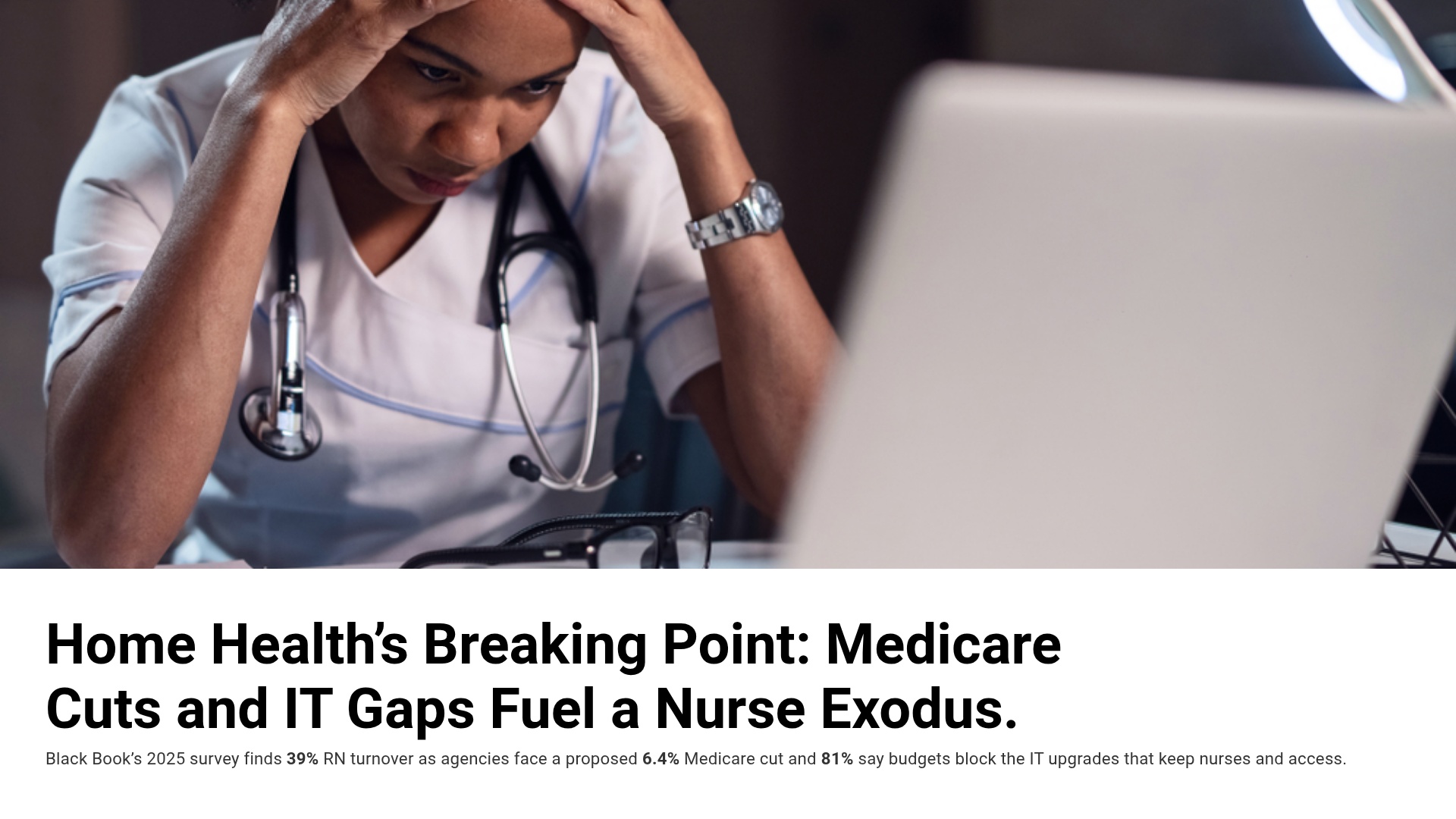Black Book survey: IT modernization is the lever to keep home health nurses and protect access as Medicare rate changes loom
TAMPA, FL / ACCESS Newswire / September 16, 2025 / Black Book Research today released 2025 survey findings from U.S. home health executives, finance leaders, and clinical directors showing that technology inefficiencies are a primary driver of nurse attrition. Respondents also warn that proposed Medicare home health payment reductions totaling 6.4% over 2026-2027 will intensify workforce pressure unless agencies can invest in modern IT.

Home health is absorbing rising acuity while competing for nurses with hospitals and ambulatory settings. In Black Book's 2025 survey, 39% of registered nurses left home health positions in the last 12 months-more than double typical hospital RN turnover. In some markets, nurse turnover peaked at 74%, with home health aide turnover approaching 90%. Leaders point to tech-related friction-heavy documentation, payment delays, and outdated scheduling-as accelerants of burnout and exit.
"When documentation stacks up and payments stall, nurses leave, Modernizing core IT is now a workforce strategy, not a back-office project," said Doug Brown, Black Book Research spokesperson.
Key 2025 Survey Findings (U.S. Home Health & Hospice)
Tech-workforce link: Agencies deploying telehealth and remote patient monitoring (RPM) report RN turnover under 12%, versus nearing 20% among agencies without these tools.
Adoption & capability gaps: 46% of providers have implemented RPM for chronic and post-acute care. 75% of rural providers report interoperability challenges tied to legacy systems; agencies fully integrated with EHR/HIEs see measurable gains in care coordination and nurse satisfaction.
Budget headwinds: 91% cite budget limitations as the top barrier to upgrading or adopting IT (EHRs, telehealth platforms, automated scheduling, mobile documentation).
Consensus on interoperability: 100% of post-acute executives agree that better EHR/HIE interoperability with hospitals and physician groups would materially improve performance under value-based care.
What Home Health Agencies Say They Need Now
Streamlined Home Health EHR documentation & AI assistance - Top-2 priority: 72% | Rank #1: 36%
Why it matters: Cuts repetitive data entry, speeds OASIS completion, and reduces after-hours charting-directly easing burnout and improving visit quality.
Smarter scheduling & routing - Top-2: 66% | Rank #1: 28%
Why it matters: Increases visit density and reduces windshield time so nurses spend more minutes with patients, hit start-of-care windows, and keep caseloads stable.
Telehealth & remote patient monitoring (RPM) - Top-2: 59% | Rank #1: 20%
Why it matters: Manages low-acuity needs between visits, flags deterioration earlier, and avoids unnecessary in-person encounters-protecting capacity for higher-acuity patients.
Integrated Home Health revenue cycle management (RCM) - Top-2: 57% | Rank #1: 16%
Why it matters: Reduces denials and coding disputes, accelerates clean claims, and shortens payment cycles-cutting paycheck friction that drives attrition.
HIT Funding Gap Compared to Hospitals and Physicians
Hospitals and physician practices received $30B+ in federal EHR incentive payments through the HITECH Act; home health agencies were not eligible. Despite exclusion from incentives, agencies must meet growing digital mandates (e.g., OASIS submissions) and perform under Home Health Value-Based Purchasing (HHVBP)-leaving many without capital for necessary upgrades precisely as reimbursement pressure rises.
Congressional & Regulatory Industry Context
Home Health Stabilization Act of 2025 (H.R. 5142): bipartisan bill proposing a pause on Medicare home health rate cuts in 2026-2027.
CMS CY 2026 Proposed Rule: an aggregate 6.4% reduction via permanent and temporary behavioral adjustments, plus PDGM and HHVBP updates; the proposal has drawn extensive public comment from across the sector.
MedPAC (March 2025): recommended a 7% base-rate reduction for 2026.
Vendor Rankings in U.S. Home Health IT (Black Book 2025)
The 2025 Black Book Home Health IT & Workforce Survey reflects 441 validated responses from U.S. agency executives, financial managers, and clinical leaders. Findings analyze the links between technology adoption, workforce retention, and Medicare policy. Black Book's benchmark framework evaluates vendors and products across 36 key performance indicators (18 vendor performance KPIs; 18 product performance KPIs).
Home Health & Hospice EHRs:
Large agencies: Netsmart (myUnity®)
Small agencies: Alora Health
Hospice: RXNT
Ambulatory/Specialty EHRs impacting home health referrals & coordination:
NextGen Healthcare (Medical Specialties), ModMed (Surgical Specialties), Veradigm EHR (Family and General Practices)
Home Health Sector Revenue Cycle Management platforms (payer-provider integration & payment integrity):
Optum, Change Healthcare, Waystar, HealthEdge
*All Rankings derive from Black Book's KPI-based satisfaction surveys; Black Book is vendor-agnostic and independent.
About Black Book
Since 2011, Black Book has been healthcare's independent benchmark source, polling technology users worldwide and publishing KPI-driven rankings across the continuum of care. Black Book remains vendor-agnostic and non-commissioned, producing research for providers, payers, investors, and policymakers. Download free industry reports at www.BlackBookMarketResearch.com
Contact Information
Press Office
research@blackbookmarketresearch.com
8008637590
SOURCE: Black Book Research
View the original press release on ACCESS Newswire:
https://www.accessnewswire.com/newsroom/en/healthcare-and-pharmaceutical/medicare-cuts-and-tech-gaps-drive-home-health-nurse-exodus-1072816
